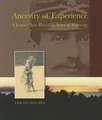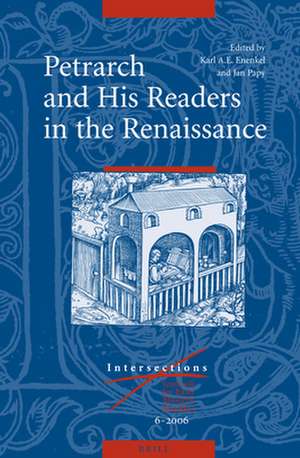Petrarch and His Readers in the Renaissance: Intersections, cartea 6
Karl A. E.. Enenkel, Jan Papyen Limba Engleză Hardback – 25 ian 2006
Contributors include: Jean Balsamo, Dóra Bobory, Dina De Rentiis, Ugo Dotti, Karl A.E. Enenkel, Reindert L. Falkenburg, Ursula Kocher, Marc Laureys, Reinier Leushuis, Jan Papy, Paul J. Smith, and Bart Van den Bossche.
Din seria Intersections
-
 Preț: 215.61 lei
Preț: 215.61 lei -
 Preț: 200.26 lei
Preț: 200.26 lei -
 Preț: 154.86 lei
Preț: 154.86 lei -
 Preț: 192.18 lei
Preț: 192.18 lei -
 Preț: 98.61 lei
Preț: 98.61 lei -
 Preț: 217.51 lei
Preț: 217.51 lei -
 Preț: 116.09 lei
Preț: 116.09 lei - 18%
 Preț: 1074.49 lei
Preț: 1074.49 lei -
 Preț: 241.64 lei
Preț: 241.64 lei -
 Preț: 241.64 lei
Preț: 241.64 lei -
 Preț: 228.96 lei
Preț: 228.96 lei -
 Preț: 229.55 lei
Preț: 229.55 lei -
 Preț: 241.64 lei
Preț: 241.64 lei -
 Preț: 226.67 lei
Preț: 226.67 lei -
 Preț: 107.21 lei
Preț: 107.21 lei -
 Preț: 208.79 lei
Preț: 208.79 lei -
 Preț: 201.78 lei
Preț: 201.78 lei -
 Preț: 226.85 lei
Preț: 226.85 lei -
 Preț: 225.71 lei
Preț: 225.71 lei -
 Preț: 246.63 lei
Preț: 246.63 lei -
 Preț: 228.96 lei
Preț: 228.96 lei - 47%
 Preț: 319.92 lei
Preț: 319.92 lei - 7%
 Preț: 315.66 lei
Preț: 315.66 lei -
 Preț: 96.10 lei
Preț: 96.10 lei - 18%
 Preț: 1201.75 lei
Preț: 1201.75 lei - 18%
 Preț: 659.69 lei
Preț: 659.69 lei - 18%
 Preț: 693.26 lei
Preț: 693.26 lei - 18%
 Preț: 1049.43 lei
Preț: 1049.43 lei - 18%
 Preț: 698.32 lei
Preț: 698.32 lei - 18%
 Preț: 681.99 lei
Preț: 681.99 lei - 18%
 Preț: 687.25 lei
Preț: 687.25 lei - 18%
 Preț: 820.59 lei
Preț: 820.59 lei - 18%
 Preț: 683.37 lei
Preț: 683.37 lei - 18%
 Preț: 667.86 lei
Preț: 667.86 lei
Preț: 653.27 lei
Preț vechi: 796.67 lei
-18% Nou
Puncte Express: 980
Preț estimativ în valută:
125.00€ • 130.84$ • 104.04£
125.00€ • 130.84$ • 104.04£
Carte indisponibilă temporar
Doresc să fiu notificat când acest titlu va fi disponibil:
Se trimite...
Preluare comenzi: 021 569.72.76
Specificații
ISBN-13: 9789004147669
ISBN-10: 9004147667
Pagini: 338
Greutate: 0 kg
Editura: Brill
Colecția Brill
Seria Intersections
ISBN-10: 9004147667
Pagini: 338
Greutate: 0 kg
Editura: Brill
Colecția Brill
Seria Intersections
Public țintă
All scholars interested in literature, humanism, Renaissance, reception of texts, Petrarch and the intellectual history of the Early Modern Period.Cuprins
Acknowledgements
Notes on the Editors of this Volume
List of Contributors
Introduction: Towards a New Approach of Petrarch’s Reception in the Renaissance—the ‘Independent Reader’, Karl A.E. Enenkel & Jan Papy
PETRARCH AND HIS 14TH-CENTURY READERS
1. Creating an ‘Italian’ Friendship: from Petrarch’s Ideal Literary Critic ‘Socrates’ to the Historical Reader Ludovicus Sanctus of Beringen, Jan Papy
2. Antiquarianism and Politics in 14th-century Avignon: the Humanism of Giovanni Cavallini, Marc Laureys
3. „Interpres rerum tuarum“—Boccaccio und Petrarca, eine ungleiche Freundschaft, Ursula Kocher
4. Petrarch in Bohemia: Culture and Civil Life in the Correspondence between Petrarch and Johann von Neumarkt, Ugo Dotti
PETRARCH IN 16TH-CENTURY GERMANY: THE CASE OF THE ‘PETRARCH MASTER’
5. Der Petrarca des ,Petrarca-Meisters‘: zum Text-Bild-Verhältnis in illustrierten De remediis-Ausgaben, Karl A.E. Enenkel
6. Speculative Imagery in Petrarch’s Von der Artzney bayder Glueck (1532), Reindert L. Falkenburg
16TH-CENTURY ITALIANS READING PETRARCH: BEMBO AND CARDANO
7. «Quegli amori che son dolci senza amaritudine»: the Petrarchist Bembo in The Book of the Courtier, Bart Van den Bossche
8. An Unusual Biography: Cardano’s Horoscope of Petrarch, Dóra Bobory
PETRARCH READ AND IMITATED IN 16TH-CENTURY FRANCE
9. Visions of Ruin: vanitas vanitatum in Du Bellay’s Songe and Petrarch’s Canzone delle visioni (Rime 323), Reinier Leushuis
10. Truth is Just an Option: Du Bellay’s Philosophical Critique of Imitation in Contre les Pétrarquistes, Dina De Rentiis
11. Poetical and Political Readings of Petrarch’s Rime in XVIth-Century France: A Critical Revaluation, Jean Balsamo
PETRARCH TRANSLATED AND ILLUSTRATED IN THE LOW COUNTRIES
12. Petrarch Translated and Illustrated in Jan van der Noot’s Theatre (1568), Paul J. Smith
List of Illustrations
Index Nominum
Notes on the Editors of this Volume
List of Contributors
Introduction: Towards a New Approach of Petrarch’s Reception in the Renaissance—the ‘Independent Reader’, Karl A.E. Enenkel & Jan Papy
PETRARCH AND HIS 14TH-CENTURY READERS
1. Creating an ‘Italian’ Friendship: from Petrarch’s Ideal Literary Critic ‘Socrates’ to the Historical Reader Ludovicus Sanctus of Beringen, Jan Papy
2. Antiquarianism and Politics in 14th-century Avignon: the Humanism of Giovanni Cavallini, Marc Laureys
3. „Interpres rerum tuarum“—Boccaccio und Petrarca, eine ungleiche Freundschaft, Ursula Kocher
4. Petrarch in Bohemia: Culture and Civil Life in the Correspondence between Petrarch and Johann von Neumarkt, Ugo Dotti
PETRARCH IN 16TH-CENTURY GERMANY: THE CASE OF THE ‘PETRARCH MASTER’
5. Der Petrarca des ,Petrarca-Meisters‘: zum Text-Bild-Verhältnis in illustrierten De remediis-Ausgaben, Karl A.E. Enenkel
6. Speculative Imagery in Petrarch’s Von der Artzney bayder Glueck (1532), Reindert L. Falkenburg
16TH-CENTURY ITALIANS READING PETRARCH: BEMBO AND CARDANO
7. «Quegli amori che son dolci senza amaritudine»: the Petrarchist Bembo in The Book of the Courtier, Bart Van den Bossche
8. An Unusual Biography: Cardano’s Horoscope of Petrarch, Dóra Bobory
PETRARCH READ AND IMITATED IN 16TH-CENTURY FRANCE
9. Visions of Ruin: vanitas vanitatum in Du Bellay’s Songe and Petrarch’s Canzone delle visioni (Rime 323), Reinier Leushuis
10. Truth is Just an Option: Du Bellay’s Philosophical Critique of Imitation in Contre les Pétrarquistes, Dina De Rentiis
11. Poetical and Political Readings of Petrarch’s Rime in XVIth-Century France: A Critical Revaluation, Jean Balsamo
PETRARCH TRANSLATED AND ILLUSTRATED IN THE LOW COUNTRIES
12. Petrarch Translated and Illustrated in Jan van der Noot’s Theatre (1568), Paul J. Smith
List of Illustrations
Index Nominum
Notă biografică
Karl A.E. Enenkel is Professor of Neo-Latin Literature at Leiden University and teaches classical Latin and Neo-Latin in the Department of Classics. He is the author of Francesco Petrarca: De vita solitaria, Buch 1. Kritische Textausgabe und ideengeschichtlicher Kommentar and of Kulturoptimismus und Kulturpessimismus in der Renaissance, editor and (co)author of Modelling the Individual. Biography and Portrait in the Renaissance (1998), Lipsius in Leiden (1997), Recreating Ancient History (2001) and of several studies on the reception of Classical Literature in the Early Modern Times. He has (co)edited recently Mundus Emblematicus. Studies on Neo-Latin Emblem Books (2003), The Manipulative Mode. Political Propaganda in Antiquity (2005) and Cognition and the Book. Typologies of Formal Organisation of Knowledge in the Printed Book of the Early Modern Period (2005). He has published extensively on international Humanism and on the reception of Classical Antiquity and is the general editor of Intersections. Yearbook for Early Modern Studies.
Jan Papy is Research Professor of Neo-Latin at the Catholic University of Leuven. His research focuses mainly on Italian humanism (Petrarch, Pico della Mirandola), Humanism in the Low Countries (Vives, Erasmus, Lipsius), Intellectual History and Renaissance Philosophy in the Low Countries (16th-17th centuries). He is the author of numerous articles dealing with subjects related to these fields. Besides, he is the editor of Iusti Lipsi Epistolae: Pars XIII (1600), Koninklijke Vlaamse Academie van België voor Wetenschappen en Kunsten (Brussels, 2000), and he has co-edited Justus Lipsius, Europae lumen et columen. Proceedings of the International Colloquium Leuven-Antwerp, 17-20 September 1997 (Leuven, 1999), and Self-Presentation and Social Identification. The Rhetoric and Pragmatics of Letter Writing in Early Modern Times (Leuven, 2002). He is member of the editorial board of Humanistica Lovaniensia: Journal for Neo-Latin Studies.
Jan Papy is Research Professor of Neo-Latin at the Catholic University of Leuven. His research focuses mainly on Italian humanism (Petrarch, Pico della Mirandola), Humanism in the Low Countries (Vives, Erasmus, Lipsius), Intellectual History and Renaissance Philosophy in the Low Countries (16th-17th centuries). He is the author of numerous articles dealing with subjects related to these fields. Besides, he is the editor of Iusti Lipsi Epistolae: Pars XIII (1600), Koninklijke Vlaamse Academie van België voor Wetenschappen en Kunsten (Brussels, 2000), and he has co-edited Justus Lipsius, Europae lumen et columen. Proceedings of the International Colloquium Leuven-Antwerp, 17-20 September 1997 (Leuven, 1999), and Self-Presentation and Social Identification. The Rhetoric and Pragmatics of Letter Writing in Early Modern Times (Leuven, 2002). He is member of the editorial board of Humanistica Lovaniensia: Journal for Neo-Latin Studies.
Recenzii
"This book covers a wide range of fields – Petrarch and his contemporaries, art history, the religious changes of the sixteenth century, and Petrarch's literary influence throughout Europe. The papers, of a high standard, are a valuable contribution to our knowledge of Italy's great poet."
Alastair Hamilton, The Warburg Institute, London. In: Church History and Religious Culture, Vol. 87, No. 4 (2007), pp. 551-552.
Alastair Hamilton, The Warburg Institute, London. In: Church History and Religious Culture, Vol. 87, No. 4 (2007), pp. 551-552.
